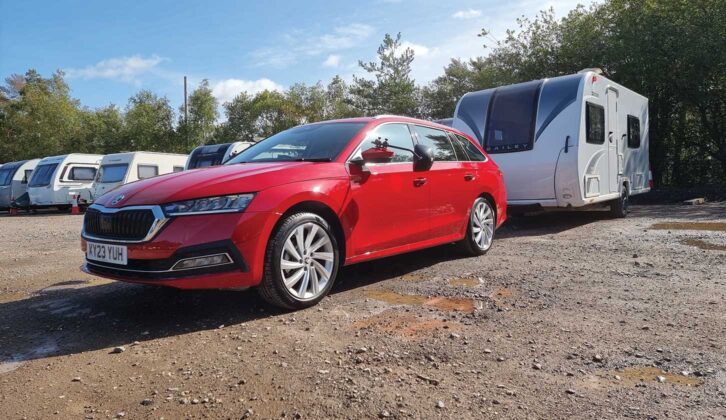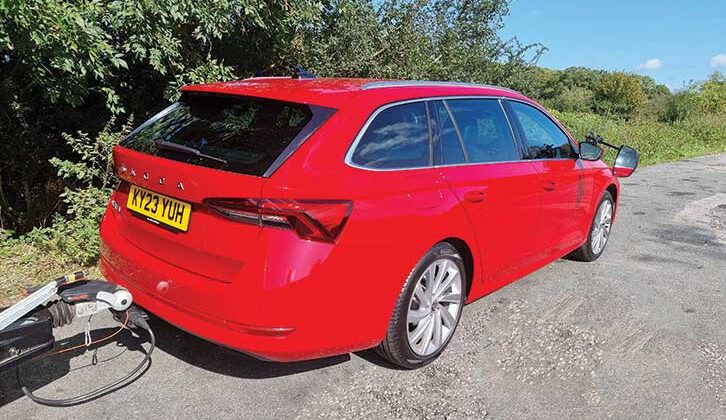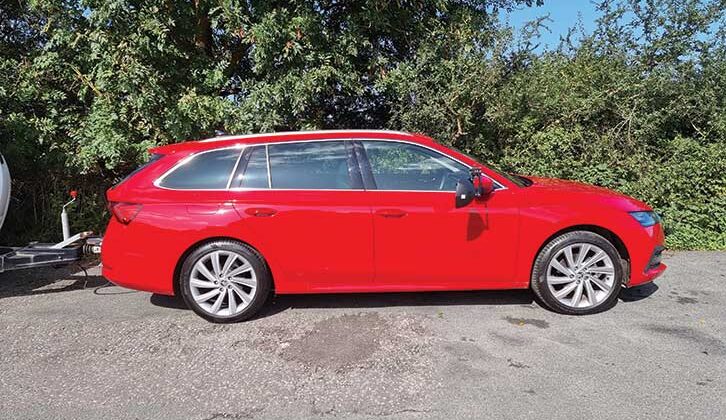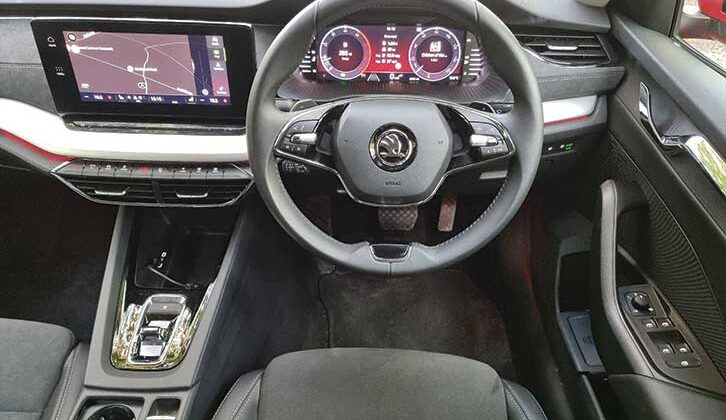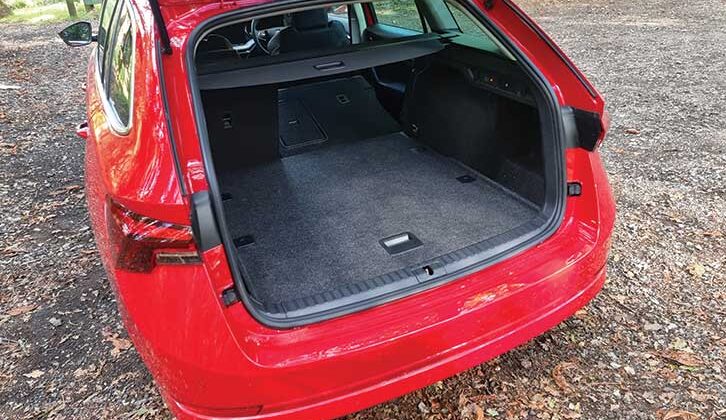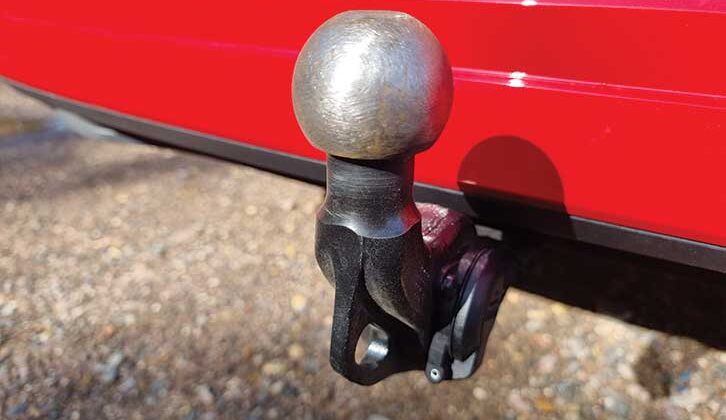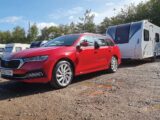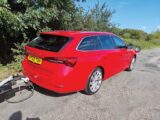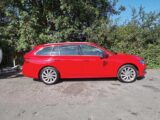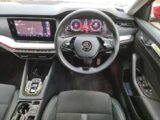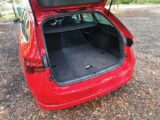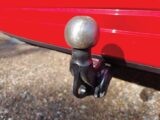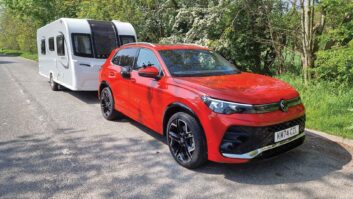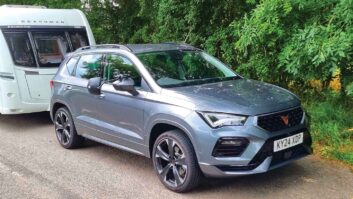Škoda updated the Octavia a while back, with new looks and a revised cabin, better materials and extra high-tech equipment. As before, customers have the choice of hatchback and estate models, and it’s the 2.0-litre diesel estate that we’re testing here.
What are we looking for?
The best caravan tow cars offer stability and reliability, so is there much movement when we tow with the Octavia? Have the changes improved it? And is this still one of the standout family estates for caravanners to consider?
Towing ability in the Škoda Octavia Estate
Škoda quotes a range of kerbweights for the Octavia. Including the driver, this model has a kerbweight of 1477-1672kg, depending on the exact specification. Working from the lower weight gives an 85% match figure, which is usually recommended for safe and stable towing, of 1255kg.
As well as the front-wheel-drive model we’re testing here, there’s also a 4×4 tow car, which boosts the kerbweight to at least 1575kg. It’s an appealing upgrade if you tow all year round, but adds £1520 to the price.
We matched the Octavia to the Bailey Discovery D4-4 from our long-term fleet, with a MiRO of 1059kg.
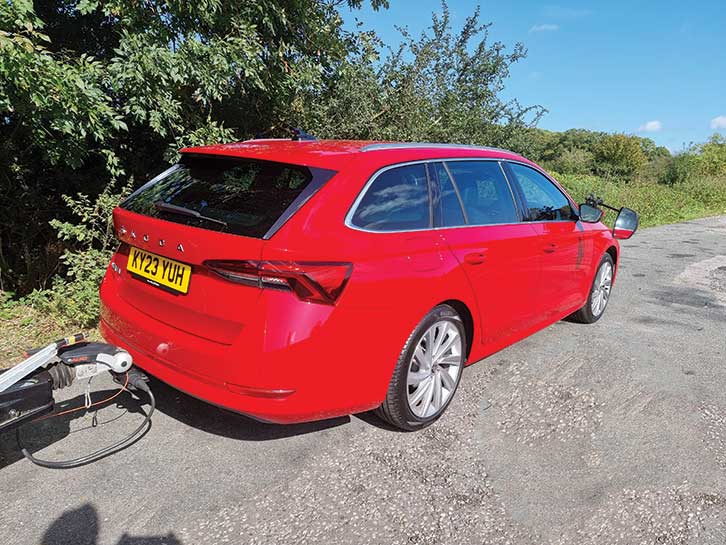
The Škoda had no trouble pulling such a light caravan, and from past experience, we know the 150hp 2.0-litre diesel tow car can pull much heavier tourers without complaint. We could easily reach 60mph before the end of the motorway sliproad, to blend seamlessly with traffic.
We mostly left the DSG auto to its own devices in ‘drive’, but changing to ‘sport’ made the ’box noticeably more responsive, which proved useful on hilly roads or if we wanted decisive acceleration.
Hill starts were straightforward in dry weather. The electronic parking brake held both car and caravan still and released with no complaints. So long as we applied the throttle smoothly, the Octavia pulled the van to the top of the slope without fuss.
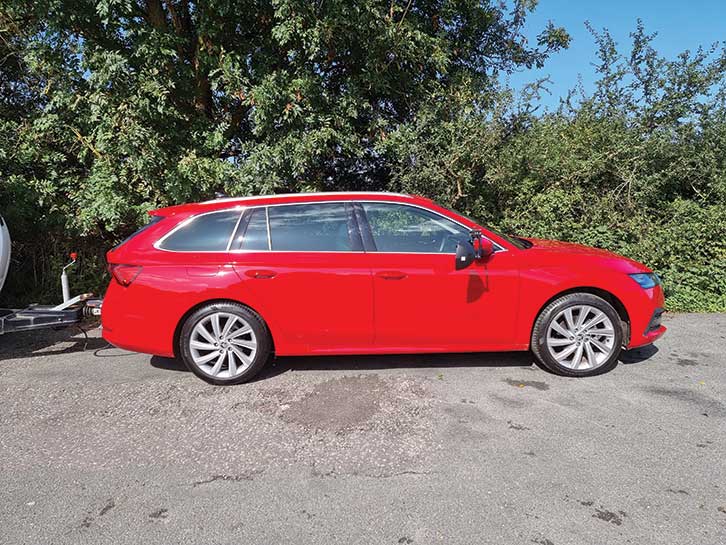
That said, on one or two occasions, the wheels did spin briefly when pulling away briskly from a junction.
The four-wheel-drive model would surely put its power to the road more cleanly, especially in wet conditions.
Once up to speed, the Octavia is very well behaved. When we hit the caravan speed limit, a steady 60mph, in clean air, we found the Škoda tows straight and true.
The driver can feel some movement from the caravan gently pulling at the back of the car when being overtaken by high-sided vehicles. These movements are slight, though, and last a moment before car and caravan are towing straight again.
In our book, the Škoda Octavia is right up there with the best small family estate tow cars for secure and stable towing. We’d say that the Volkswagen Golf Estate just has the edge, thanks to its tauter suspension, but there’s not a great deal in it.
Solo driving the Škoda Octavia Estate
The Octavia is very easy to live with. It’s not the sharpest car for driving enthusiasts, but that’s hardly the priority with a family estate. All the sensible, everyday tasks you might ask for are handled with finesse.
Even on optional 18-inch alloys (17-inch wheels are standard for this spec), the Octavia rides smoothly. It’s more forgiving of poor surfaces than a Ford Focus or Seat Leon. Corner briskly and it leans more than some rivals, but it handles neatly enough.
The car is well suited to long motorway drives, with overtaking punch in reserve and restrained wind and road noise.
The Škoda drives well in town, thanks to light controls and good all-round visibility. A rear-view camera would be handy when parking (or hitching up), but the SE L makes do with front and rear sensors instead.
Space and practicality in the Škoda Octavia Estate
The roomy cabin has always been one of the Octavia’s chief strengths. The facelifted model is every bit as practical as before, but it’s now better finished.
Up front, there’s plenty of legroom and headroom for both driver and passenger, and enough adjustment to the seat and wheel to make it easy to find a supportive driving position. Microsuede (a synthetic suede alternative) upholstery adds to the air of quality, while the digital display gives a high-tech look and allows the driver to choose which information appears in front of them and how it is shown.
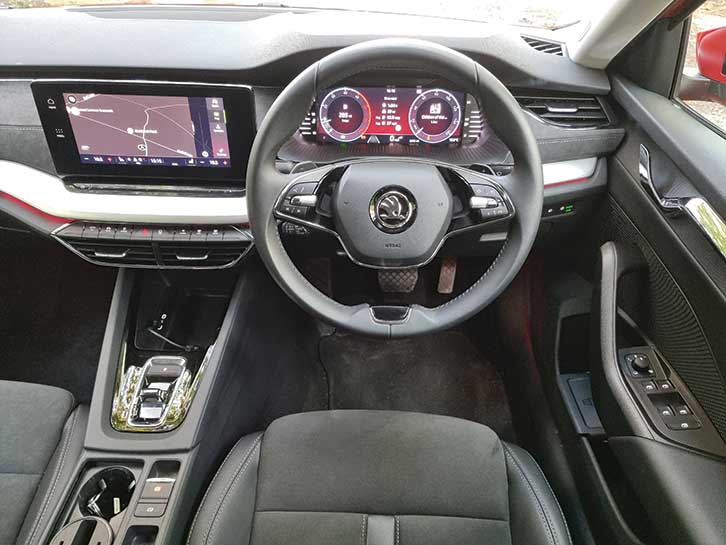
The 10-inch infotainment screen looks impressive, but it takes a while to learn its ways. There are no separate air-con controls, but they are always on screen, so you don’t need to find the right menu to adjust the temperature or fan speed.
Adults will be comfortable in the back, although the stout transmission tunnel will get in the way if there are three rear-seat passengers. There are air vents between the front seats to cool the rear of the cabin, and a couple of USB-C charging ports.
The boot is huge, at 640 litres with the rear seats upright. That’s more room than you’ll find in many bigger, more expensive estates. Folding the seats and removing the parcel shelf takes the space up to 1700 litres, giving you plenty of room for all those essentials for a caravan.
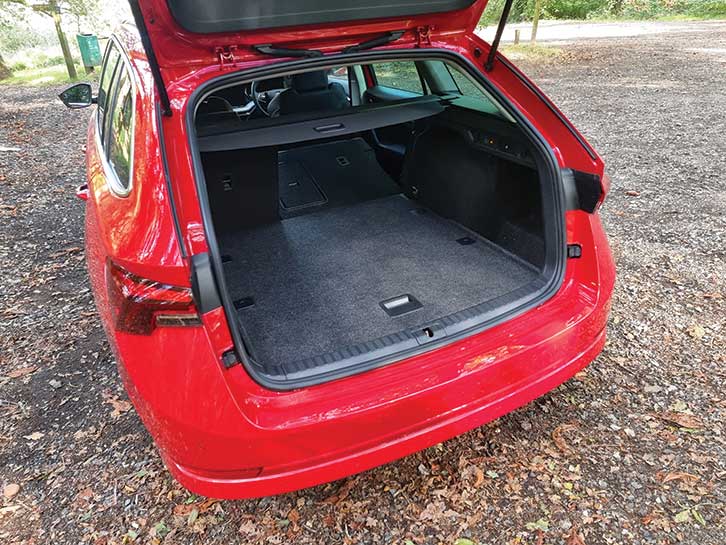
Buying and owning
Given the generous standard specification, the Octavia is fairly priced at £33,280, although What Car? magazine suggests discounts of over £2000 are available.
Running costs should be low, not least because of the car’s excellent fuel economy. We saw 60mpg or better in everyday driving, and the Škoda returned 30.6mpg while towing the Bailey.
The car has a five-star safety rating from Euro NCAP, although some driver aids, such as blind spot detection, are optional.
Verdict
There’s not a lot wrong with the Octavia, especially in this spec. It’s fuel-efficient, stable and exceptionally practical.
Alternatives to consider
The Ford Focus Estate 1.0 EcoBoost 155PS mHEV Active X Powershift may have less torque than the Octavia Estate but offers competent towing with a well-matched caravan. Another option to think about is the Škoda Kamiq 1.5 TSI 150PS Monte Carlo – it’s a small option which feels sporty both inside and out.
Technical spec
- Price: £33,280
- What Car? Target Price: £30,991
- Retained value after three years: 48%
- Kerbweight: 1477-1672kg
- 85% of kerbweight: From 1255kg
- Gross vehicle weight: 1990kg
- Max towing limit: 1600kg
- Gross train weight: 3590kg
- Towball limit: 80kg
- Towball and electrics: £1055
- Boot size: 640-1700 litres
- Payload: From 513kg
- Test conditions: Dry
- Engine size: 1968cc
- Power (hp)/rpm: 150@3000-4200rpm
- Torque (lb ft)/rpm: 266@1600-2750rpm
- Official combined economy: 58.6-62.3mpg
- Towing economy: 30.6mpg
- CO2 emissions: 117-126g/km
- First year car tax: £210
- Second year car tax: £180
- Insurance group: 21E
- Euro NCAP rating: 5/5
If you’ve enjoyed reading this article, why not get the latest news, reviews and features delivered direct to your door or inbox every month. Take advantage of our brilliant Practical Caravan magazine SUBSCRIBERS’ OFFER and SIGN UP TO OUR NEWSLETTER for regular weekly updates on all things caravan related
Technical Specifications
| Engine Size | 1968 cc |
| Kerbweight | 1477-1672 kg |
| 85% KW | From 1255 kg |
| Towball Limit | 80 kg |
| Maximum Towing Limit | 1600 kg |
| Power | 150 bhp |
| Torque | 266 lb ft |
| Offical MPG | 58.6-62.3 mpg |
| Towing MPG | 30.6 mpg |
| CO₂ | 117-126 g/km |
